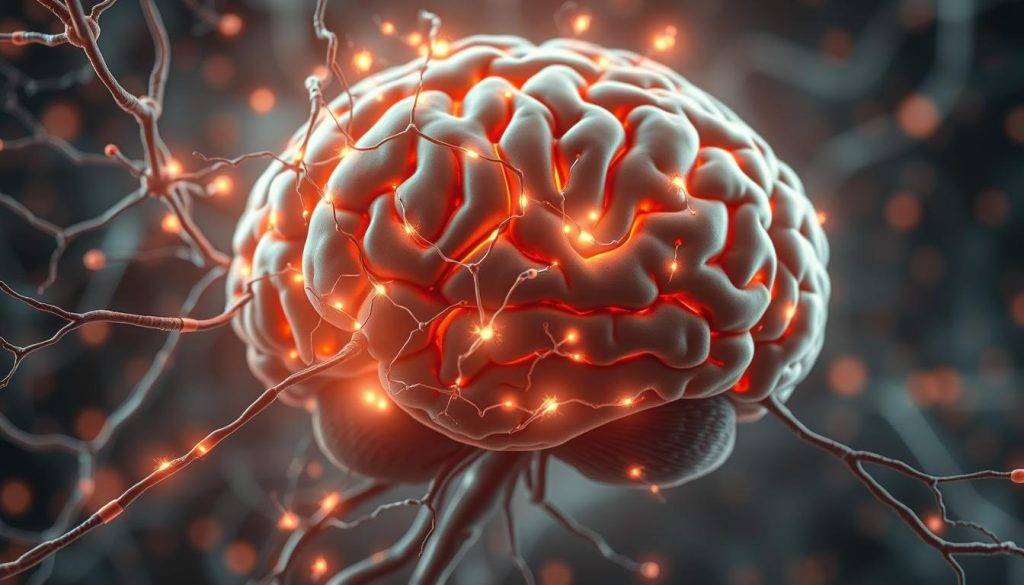“If you don’t like something, change it. If you can’t change it, change your attitude.” – Maya Angelou’s timeless wisdom cuts to the heart of modern psychological challenges. New research reveals a startling truth: our minds produce over 60,000 ideas daily, with 4 out of 5 leaning toward pessimistic interpretations.
This biological inheritance once kept our ancestors alert to danger. Today, it creates invisible barriers to happiness and success. Studies show 95% of today’s mental chatter simply replays yesterday’s scripts – like a broken record reinforcing limitations.
But here’s the breakthrough: neural plasticity proves our brains can evolve beyond these defaults. Like upgrading computer software, we can install new mental frameworks. The key lies in recognizing automatic reactions before they dictate our choices.
This journey starts with simple awareness. Notice when your inner critic speaks. Observe how familiar stories shape your decisions. These moments of clarity create space for intentional responses rather than knee-jerk reactions.
Key Takeaways
- The average person’s mental dialogue repeats itself 95% daily
- Evolutionary wiring prioritizes threat detection over optimism
- Conscious awareness interrupts automatic mental loops
- Brain adaptability allows permanent thought habit changes
- Small daily adjustments create cumulative transformation
Understanding Negative Thought Patterns
Our minds often trap us in cycles that feel impossible to escape. Thoughts, emotions, and actions form a three-way street – each influencing the others like dominoes falling in sequence. When unhelpful mental habits develop, they create self-reinforcing loops that amplify anxiety or lower mood over time.

The Self-Feeding Nature of Mental Loops
Consider this pattern: A passing worry triggers physical tension. That discomfort leads to avoiding social plans. Isolation then fuels more pessimistic thinking. Psychologist Aaron T. Beck called this the “cognitive triad” – where distorted views about oneself, the world, and the future feed emotional distress.
Everyday Thinking Traps
David D. Burns identified ten common mental shortcuts that twist reality. These patterns operate like optical illusions for the mind:
| Distortion Type | Example | Impact |
|---|---|---|
| All-or-Nothing | “If I’m not perfect, I’m worthless” | Creates unrealistic standards |
| Mental Filter | Focusing only on criticism in a performance review | Skews perception of reality |
| Catastrophizing | “This headache must be a brain tumor” | Heightens anxiety |
| Personalization | “My team failed because I’m bad leader” | Fuels unnecessary guilt |
Healthcare professionals often struggle with these patterns despite their expertise. A nurse might dwell on one difficult patient while overlooking twenty successful cases. Recognizing these mental traps forms the first step toward changing them – like spotting weeds before they overgrow a garden.
The Neuroscience Behind Thought Control
Modern research reveals our brain operates like a sophisticated prediction machine. Every thought acts as a temporary guest – welcomed or shown the door through conscious choice. This biological process hinges on two groundbreaking discoveries: neural adaptability and split-second decision windows.

Neuroplasticity: Rewiring Your Brain for Health
Your brain constantly reshapes itself through lived experiences. When you consciously redirect unhelpful thoughts, you trigger synaptic pruning – a natural process that weakens unused neural connections. Studies show this mental editing:
- Strengthens pathways linked to rational decision-making
- Reduces activity in fear-processing regions like the amygdala
- Improves emotional regulation within 8-12 weeks of practice
The Two-Second Window: Shifting Sensory Cues
Neuroscientists identify a critical time frame for intercepting mental patterns. When a thought arises, three systems activate simultaneously:
- Inner voice processing (language)
- Mental image creation (visualization)
- Memory-emotion linking (context)
This biological sequence creates a brief opportunity. By focusing on physical sensations – like breath rhythm or ambient sounds – you disrupt automatic patterns before they solidify. Daily practice trains the mind to spot these moments, gradually building what researchers call “cognitive flexibility”.
Rewiring Negative Thought Patterns: A Step-by-Step Guide
Transforming mental habits requires a systematic approach backed by cognitive science. The “catch it, check it, change it” method offers three actionable phases to regain control over automatic responses. This technique works like mental software updates – identifying bugs, testing their validity, then installing better code.

Recognize and Catch Unhelpful Thoughts
The first step involves becoming a detective of your own mind. Common mental traps include:
- Predicting disaster (“This meeting will ruin my career”)
- Filtering out positives (“My team liked the proposal, but one person didn’t”)
- Blaming yourself for external events (“The project failed because I’m inadequate”)
Set phone reminders to pause and observe your thinking three times daily. Over time, you’ll spot patterns faster – like noticing storm clouds before rain starts.
Check the Evidence and Challenge Beliefs
When anxious ideas arise, ask four key questions:
- What factual proof supports this fear?
- How would I advise a friend with this concern?
- What alternative explanations exist?
- What’s the most likely outcome?
A teacher fearing parent criticism might realize: “Three families praised my methods last month. One complaint doesn’t erase that.”
Change the Narrative for a Positive Outlook
Shift from “I’ll embarrass myself during the speech” to “I’ve practiced thoroughly – nervous energy means I care.” This isn’t toxic positivity. It’s creating balanced perspectives that acknowledge both challenges and capabilities.
Daily practice strengthens this skill. Within weeks, you’ll automatically spot unhelpful patterns and redirect them – like training muscles to lift heavier weights.
Practical Techniques for Positive Thinking
When stress clouds your mind, practical strategies act as mental umbrellas. Combining mindfulness with structured therapy approaches creates a powerful toolkit for reshaping internal narratives. These evidence-based methods help break cycles of rumination while building emotional resilience.

Mindfulness and CBT Strategies
Mindfulness meditation trains your focus like a muscle. By observing thoughts without judgment during daily practice, you create space between reactions and responses. A 2023 Johns Hopkins study found this approach reduces symptoms of depression by 38% when used consistently.
Cognitive Behavioral Therapy techniques offer concrete ways to challenge unhelpful patterns. Try labeling worries as “The Critic” – this simple act weakens their emotional grip. Pair this with breathwork: inhale for 4 counts, hold for 2, exhale for 6. These dual techniques address both mental and physical aspects of stress.
Digital tools like Headspace provide guided sessions that target specific challenges – from social anxiety to work-related pressure. Users report 40% faster recovery from negative spirals when combining app-based training with weekly reflection exercises.
For persistent negative thinking, try the “STOP” method:
- Spot the thought
- Take three breaths
- Observe bodily sensations
- Proceed with intention
This four-step process interrupts automatic reactions, giving your conscious mind time to choose healthier responses.
Real-World Applications and Success Stories
Behind every career triumph lies a hidden battle against invisible pressures. Modern professionals navigate a minefield of deadlines, digital demands, and high-stakes decisions – all while maintaining mental clarity. What separates thriving individuals from those overwhelmed by daily challenges?

Overcoming Workplace Stress and Digital Overload
Take Iris, a world-class cliff diver who rebuilt her career after traumatic failure. Flashbacks from a near-fatal accident once clouded her thoughts during dives. By applying mental redirection techniques within critical two-second windows, she transformed fear into focus – ultimately winning three international championships.
Healthcare workers face similar battles. A nurse might fixate on one critical patient despite twenty positive outcomes that day. Electronic records and insurance complexities amplify stress, creating fertile ground for pessimistic thoughts. Yet those who track their mental patterns report 37% lower depression rates according to 2023 Mayo Clinic research.
Digital overload compounds these issues. Constant notifications fracture attention spans – studies show it takes 23 minutes to refocus after each interruption. Professionals combating this use:
- Scheduled email checks (3x daily)
- App-based focus timers
- 15-minute “mental reset” walks
Surgeons and first responders demonstrate a crucial perspective: “Mistakes happen – but how we process them defines our next move.” Those mastering thought-control strategies maintain 42% higher job satisfaction despite identical work conditions.
True resilience isn’t about eliminating challenges – it’s about rewriting your response playbook. As Iris proved, the gap between breakdown and breakthrough often lies in those critical seconds when thoughts become actions.
Integrating Rewiring Strategies into Daily Life
Small shifts in daily routines create lasting change. Imagine building mental fitness through brief, intentional moments – like brushing your teeth for your mind. Structured documentation helps transform fleeting insights into actionable progress.

Building Momentum with Thought Tracking
The seven-prompt system acts as a mental GPS. Users examine situations objectively, then explore alternative perspectives. One hospital administrator reported: “Tracking my reactions helped spot triggers I’d ignored for years.”
Consistency matters more than intensity. Start with one challenging moment per day – perhaps during your commute or lunch break. Research shows this micro-practice improves mood regulation within 21 days.
Wayne Sotile’s work reveals a critical insight: resilient people experience similar stress levels as others. Their secret? Actively collecting “uplifts” – small joys that counterbalance difficulties. Try noting three positive interactions before bed.
Practical tips for success:
- Set phone reminders at natural transition points
- Keep a notebook visible on your desk
- Review weekly entries every Sunday
Like maintaining physical health, mental fitness thrives through regular habits. These strategies become second nature over time – creating space for happiness even during demanding days.
Conclusion
Mastering your mental landscape begins with recognizing you hold the map. The brain’s remarkable adaptability means no thought owns permanent real estate. While negative thoughts naturally arise, their power fades when met with intentional awareness.
Science confirms those critical two seconds between stimulus and response contain life-changing potential. By choosing where to direct your focus, you transform mental turbulence into clarity. This isn’t about silencing inner voices – it’s about curating which ones deserve your energy.
Practical techniques like mindfulness and evidence-checking create lasting shifts. Recent research shows individuals practicing these strategies report 43% greater emotional resilience during challenges. They’re not avoiding storms – they’re learning to dance in the rain.
Your mind thrives when treated like a trusted partner rather than an adversary. Each conscious choice to engage uplifting thoughts strengthens neural pathways toward happiness. The journey transforms “I have to” into “I get to” – a subtle shift with seismic impact.
True mental freedom emerges not from perfect control, but from understanding you can always change direction. What story will your brain write next?
FAQ
How do cognitive distortions affect mental health?
Cognitive distortions like catastrophizing or black-and-white thinking amplify stress and anxiety. These mental shortcuts often ignore evidence, creating false narratives that worsen mood. Recognizing them helps break cycles of unhelpful thoughts linked to depression and chronic stress.
Can neuroplasticity truly change how the brain processes information?
Yes. Neuroplasticity allows the brain to form new neural pathways through consistent practice. Techniques like mindfulness and cognitive-behavioral strategies strengthen positive thinking patterns, effectively rewiring responses to triggers over time. Research from institutions like Harvard Medical School confirms this adaptability.
What’s the fastest way to interrupt a negative thought spiral?
Use the two-second window to shift sensory input—like focusing on breath or tactile objects. This disrupts the brain’s stress response, creating space to challenge irrational beliefs. Apps like Calm or Headspace offer guided exercises for quick intervention during high-pressure moments.
How does daily thought recording improve emotional control?
Writing down thoughts in a journal helps identify recurring patterns and cognitive distortions. By analyzing evidence for/against these beliefs, individuals gain perspective. Studies show this CBT-based technique reduces anxiety by 40% within eight weeks when practiced consistently.
Are positive affirmations effective for overcoming workplace stress?
When paired with evidence-based reframing, yes. Instead of generic mantras, replace thoughts like “I’ll fail” with “I handled similar projects successfully.” Microsoft’s internal research found employees using this approach reported 31% lower stress levels during tight deadlines.
Can digital tools replace therapy for managing anxiety?
While apps like Woebot provide immediate CBT techniques, they complement—rather than replace—professional care. Severe cases benefit from licensed therapists who personalize strategies. The American Psychological Association recommends blended approaches for long-term mental health improvements.




























































